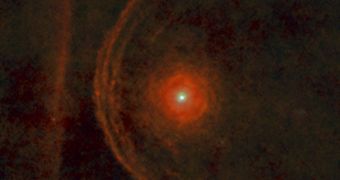Betelgeuse, one of the brightest and certainly one of the biggest stars in the sky doesn't have long to live, on a stellar time scale. But as it passes through its last few millions of years, it's creating quite a spectacle for astronomers.
The latest infrared data gathered by Hershel shows that the star is on a collision course, though it's only going to hit gas and dust.
Still, the show is already quite interesting. The image provided by ESA's Herschel space telescope shows what looks like the type of waves created in front of boats.
In fact, that's exactly what they are, as material expelled from the star hits gas and dust from the interstellar medium, it compacts, due to the collisions, and creates the pattern you see.
Betelgeuse is a giant, a red supergiant; in fact, it's 1,000 times larger in diameter than the Sun and 100,000 times brighter.
It's on its last leg too, soon enough the fusion process inside it won't be able to counteract the gravitational attraction of all that material and the star will go supernova, collapsing onto itself in a giant bang.
A million years from now, when that will happen, it's going to be brighter than the full moon. Until then though, it's heading towards a region of denser gas and dust, as it travels through the galaxy at 30 kilometers per second (18 miles per second, about 65,000 miles per hour).
It's going to be another 5,000 years before the first arc hits the bar on the left side of the image and another 12,500 till the star gets there.
The gas should heat up even more than creating a beautiful spectacle. It still won't be visible with the naked eye, but any infrared telescope will be able to pick it up.

 14 DAY TRIAL //
14 DAY TRIAL //